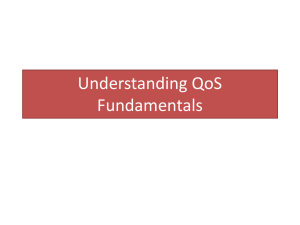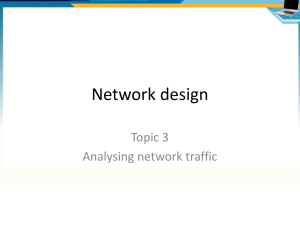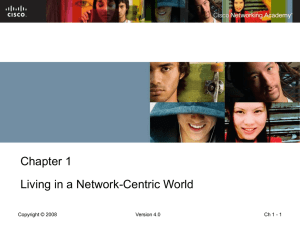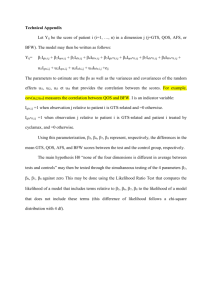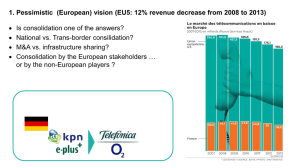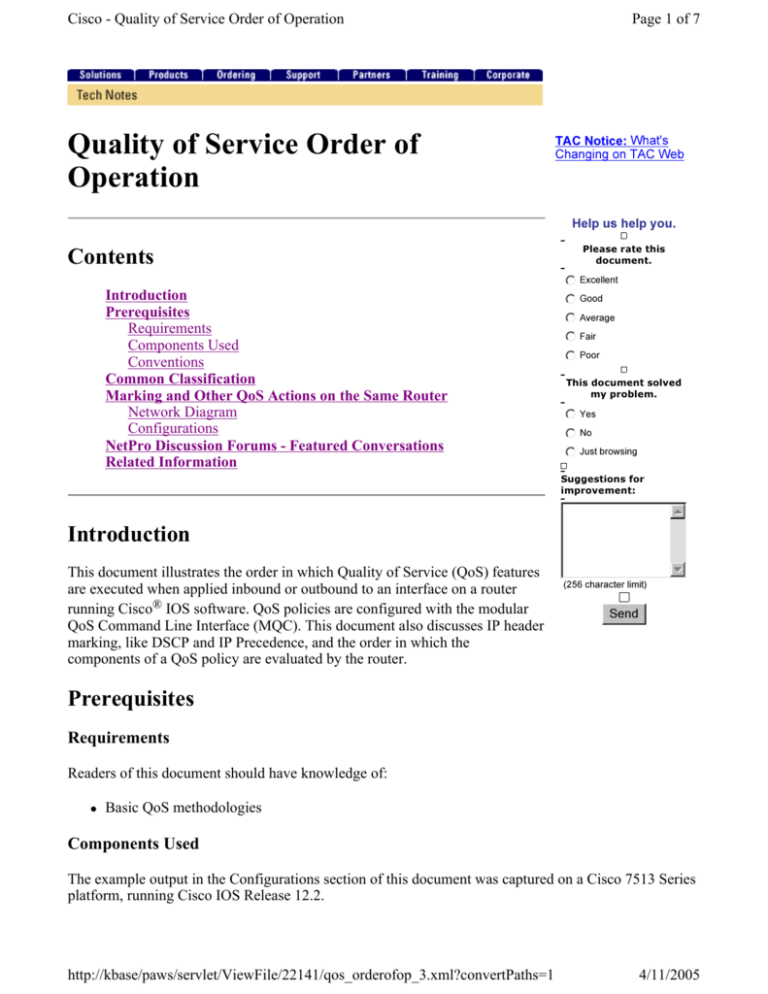
Cisco - Quality of Service Order of Operation
Quality of Service Order of
Operation
Page 1 of 7
TAC Notice: What's
C han g i n g o n T A C We b
H el p u s h el p y ou .
Contents
Introduction
Prerequisites
Requirements
Components Used
Conventions
Common Classification
Marking and Other QoS Actions on the Same Router
Network Diagram
Configurations
NetPro Discussion Forums - Featured Conversations
Related Information
Please rate this
d o c u m en t.
n Excellent
j
k
l
m
jG
k
l
m
n
o o d
nF
j
k
l
m
a ir
j
k
l
m
n
nP
j
k
l
m
A v er a g e
o o r
T his d o c u m en t so lv ed
m y p ro b lem .
jY
k
l
m
n
es
nJ
j
k
l
m
u s t b r o w s i ng
j
k
l
m
n
N o
S u g g estio n s f o r
im p ro v em en t:
Introduction
This document illustrates the order in which Quality of Service (QoS) features
are executed when applied inbound or outbound to an interface on a router
running Cisco® IOS software. QoS policies are configured with the modular
QoS Command Line Interface (MQC). This document also discusses IP header
marking, like DSCP and IP Precedence, and the order in which the
components of a QoS policy are evaluated by the router.
( 2 5 6 ch a r a cter li m i t)
Send
Prerequisites
Requirements
Readers of this document should have knowledge of:
Basic QoS methodologies
Components Used
The example output in the Configurations section of this document was captured on a Cisco 7513 Series
platform, running Cisco IOS Release 12.2.
http://kbase/paws/servlet/ViewFile/22141/qos_orderofop_3.xml?convertPaths=1
4/11/2005
Cisco - Quality of Service Order of Operation
Page 2 of 7
The information in this document was created from the devices in a specific lab environment. All of the
devices used in this document started with a cleared (default) configuration. If your network is live,
make sure that you understand the potential impact of any command.
Conventions
For more information on document conventions, refer to the Cisco Technical Tips Conventions.
Common Classification
Classification is the process of defining traffic classes that sort traffic into categories groups of flows.
Classification defines the "match criteria" for each class of traffic that is to be treated by a QoS policy.
More specifically, it defines the "traffic filter" that packets are checked against when a service-policy is
applied.
Both distributed and non-distributed platforms match packets to a single class in a policy-map. Matching
terminates at the first matching class. If two classes within a policy-map match the same IP precedence
or IP address range, the packet always belongs to the first matching class. For this reason, class order
within a policy-map is very important.
This classification approach is called "common classification" and has these benefits:
Accurate accounting and the avoidance of double-accounting problems that were seen before
"common classification".
Reduces the impact of access control lists (ACLs) on the CPU since the ACL is checked once per
class, rather than once per feature.
Faster lookup of packet headers because of caching.
Common classification is enabled automatically when you attach an input or output policy-map with the
service-policy command.
The table below illustrates the order of operation with common classification. It is important to
understand from the table when classification occurs in the context of QoS features. On the inbound
path, a packet is classified before it is switched. On the outbound path, a packet is classified after it is
switched.
Inbound
Outbound
1. QoS Policy
Propagation
through Border
Gateway Protocol
(BGP) (QPPB)
1. CEF or Fast Switching
2. Input common
classification
2. Output common
classification
http://kbase/paws/servlet/ViewFile/22141/qos_orderofop_3.xml?convertPaths=1
4/11/2005
Cisco - Quality of Service Order of Operation
3. Input ACLs
3. Output ACLs
4. Input marking
(class-based
marking or
Committed Access
Rate (CAR))
4. Output marking
5. Input policing
(through a classbased policer or
CAR)
6. IP Security (IPSec)
Page 3 of 7
5. Output policing (through a
class-based policer or
CAR)
6. Queueing (Class-Based
Weighted Fair Queueing
(CBWFQ) and Low
Latency Queueing (LLQ)),
and Weighted Random
Early Detection (WRED)
7. Cisco Express
Forwarding (CEF)
or Fast Switching
Note: Inbound Network-Based Application Recognition (NBAR) happens after ACLs and before
policy-based routing.
Important changes have been implemented regarding feature ordering and remarked value usage. These
changes include moving input CAR, input MAC, and IP precedence accounting functions to occur
before MQC output classification:
Input rate-limiting, or CAR, applies to packets following the process switching path and destined
to the router. Previously, only packets switched through the router using CEF could be ratelimited.
New IP precedence values set by input CAR or QPPB can be used for selecting a Virtual Circuit
(VC) in an ATM VC bundle.
IP precedence, Differentiated Services Code Points (DSCP), and QoS group values set by input
CAR or QPPB can be used for MQC output packet classification.
Marking and Other QoS Actions on the Same Router
A frequent application of QoS is to remark a packet and then apply an action which considers the
remarked value on the same interface or on the same router. You can configure both marking and other
QoS actions with common classification.
You can remark packets with these QoS features:
set command with class-based marking
police command with class-based policing
CAR
http://kbase/paws/servlet/ViewFile/22141/qos_orderofop_3.xml?convertPaths=1
4/11/2005
Cisco - Quality of Service Order of Operation
Page 4 of 7
This table indicates whether or not a remarked value is considered by a QoS action in a service-policy.
Location of Policy
Mark and apply
QoS action in the
same policy.
Value Used by the Outbound Policy
Actions
QoS actions use the original value of
the packet when it is commonly
classified. The packet will carry the
new value when it is transmitted, and
the next router uses the new value.
Mark with inbound
QoS actions use the new or remarked
policy and apply
value when classifying traffic against
QoS action with
the outbound policy.
outbound policy.
On the outbound path, common classification happens before any QoS features are applied. A result of
this approach is that any QoS features applied on the outbound policy act upon the original priority
value. If you need to take actions based on a remarked value on the same router, then you must mark the
packets on the incoming interface and apply other QoS actions based on this new priority on the
outgoing interface.
Network Diagram
The configurations in this section uses this network diagram:
Note: The Multilayer Switch Feature Card (MSFC) is acting as a host.
Configurations
This example demonstrates how the order of operations can affect packet marking.
Separate Marking and Shaping Policy Configuration
class-map match-all In_Mark
match any
policy-map In_Bound
class In_Mark
set ip precedence 5
!--- Use Private address below:
interface FastEthernet4/0/0
ip address 10.20.3.2 255.255.255.0
ip route-cache distributed
service-policy input In_Bound
http://kbase/paws/servlet/ViewFile/22141/qos_orderofop_3.xml?convertPaths=1
4/11/2005
Cisco - Quality of Service Order of Operation
Page 5 of 7
!--- Apply the input policy for class-based marking.
class-map match-all Out_Shaper
match ip precedence 5
!
policy Map Outbound_Shaper
class one
shape average 64000 256 256
!--- Use Private address below:
interface Serial2/0/0
ip address 172.16.20.1 255.255.255.252
ip route-cache distributed
service-policy output Outbound_Shaper
!--- Apply the output policy for class-based shaping.
Complete these steps to confirm the marking and shaping policies:
1. Use the ping command to the 172.16.20.2 destination address. The ping matches the criteria of the
class-map named "In_Mark".
msfc# ping 172.16.20.2
Type escape sequence to abort.
Sending 5, 100-byte ICMP Echos to 40.1.44.2, timeout is 2 seconds:
!!!!!
Success rate is 100 percent (5/5), round-trip min/avg/max = 8/9/12 ms
2. Use the show policy-map interface fast 4/0/0 command to view the match counters of the input
class-based marking policy. The classification mechanism is successfully matched on the IP
packets, and remarked the IP precedence value to five.
7513# show policy-map interface fast 4/0/0
FastEthernet4/0/0
Service-policy input: In_Bound
Class-map: In_Mark (match-all)
5 packets, 570 bytes
5 minute offered rate 0 bps, drop rate 0 bps
Match: any
QoS Set
ip precedence 5
Packets marked 5
Class-map: class-default (match-any)
0 packets, 0 bytes
5 minute offered rate 0 BPS, drop rate 0 BPS
Match: any
3. Use the show policy-map interface serial 2/0/0 command to view the match counters of the
outbound class-based shaping policy. The classification mechanism is successfully matched on
http://kbase/paws/servlet/ViewFile/22141/qos_orderofop_3.xml?convertPaths=1
4/11/2005
Cisco - Quality of Service Order of Operation
Page 6 of 7
the remarked IP precedence value five in the packet header, and queued the packets to the correct
class.
7513# show policy-map interface serial 2/0/0
Serial2/0/0
Service-policy output: Outbound_Shaper
Class-map: Out_Shaper(match-all)
5 packets, 520 bytes
5 minute offered rate 0 BPS, drop rate 0 BPSMatch: ip precedence 5
queue size 0, queue limit 16
packets output 5, packet drops 0
tail/random drops 0, no buffer drops 0, other drops 0
Shape: cir 64000, Bc 256, Be 256
output bytes 520, shape rate 0 BPS
Class-map: class-default (match-any)
0 packets, 0 bytes
5 minute offered rate 0 BPS, drop rate 0 BPS
Match: any (1327)
You can see what happens when we configure a single service-policy that applies both shaping and
marking to a class of traffic, as in the following example.
Single Marking and Shaping Policy Configuration
class-map match-all prec5
match any
!
policy-map shape_five
class prec5
set ip precedence 5
shape average 64000 256 256
int serial1/0/0
service-policy out shape_five
The output from the show policy-map interface serial 2/0/0 command shows that the router remarked
the five ping packets, but the packets were queued to the class-default class. The QoS classification
mechanisms on this router did not consider the remarked value in the IP precedence field.
7513# show policy-map interface serial 2/0/0
Serial2/0/0
Service-policy output: shape_five
Class-map: prec5 (match-all)
0 packets, 0 bytes
5 minute offered rate 0 BPS, drop rate 0 BPS
Match: ip precedence 5 (1377)
queue size 0, queue limit 16
packets output 0, packet drops 0
tail/random drops 0, no buffer drops 0, other drops 0
QoS Set
ip precedence 5
Packets marked 5
Shape: cir 64000, BC 256, Be 256
http://kbase/paws/servlet/ViewFile/22141/qos_orderofop_3.xml?convertPaths=1
4/11/2005
Cisco - Quality of Service Order of Operation
Page 7 of 7
output bytes 0, shape rate 0 BPS
Class-map: class-default (match-any)
5 packets, 520 bytes
5 minute offered rate 0 BPS, drop rate 0 BPS
Match: any
NetPro Discussion Forums - Featured Conversations
Networking Professionals Connection is a forum for networking professionals to share questions,
suggestions, and information about networking solutions, products, and technologies. The featured links
are some of the most recent conversations available in this technology.
NetPro Discussion Forums - Featured Conversations for RP
Service Providers: MPLS
Provision SA probes - Apr 11, 2005
MPLS destroys my network - Apr 11, 2005
Minimum, Maximum threshold and mark threshold prob calculation - Apr 11, 2005
Targetted LDP sessions - Apr 10, 2005
VLAN no connection. - Apr 9, 2005
Virtual Private Networks: Services
PPTP problems after upgrade - Apr 11, 2005
Network Bandwidth Measurement - Apr 8, 2005
Maximum connections for VPN Concentrator behind a PIX - Apr 6, 2005
Cisco qdm 2.1 - Apr 5, 2005
Error Message - Apr 4, 2005
Virtual Private Networks: Security
Cisco VPN client via IPSEC - Apr 11, 2005
PIX 520 and OS 7.0 - Apr 11, 2005
VPN Client with PIX with auth from Microsoft CA - Apr 11, 2005
Ipsec - Packet Lost - Apr 11, 2005
NAT Traversal on pix site to site VPN - Apr 11, 2005
Related Information
Qos Support Page
Technical Support - Cisco Systems
All contents are Copyright © 1992-2005 Cisco Systems, Inc. All rights reserved. Important Notices and Privacy Statement.
http://kbase/paws/servlet/ViewFile/22141/qos_orderofop_3.xml?convertPaths=1
4/11/2005



